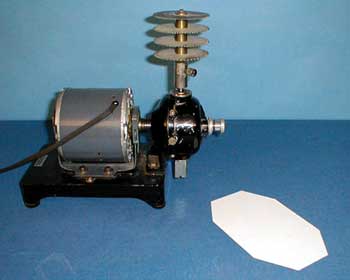Demos: 4A-01 Sound Production from Toothed Wheels

A set of sawtooth wheels is mounted on a shaft that can be turned by an electric motor. One set of wheels has the same diameter but different tooth spacing. The other set has different diameter wheels with the same tooth spacing. A card held against the teeth while the shaft is turning creates compressions and rarefactions of a frequency that is in the audible range.
Directions: First place the set with the two different diameter wheels. Engage the motor and when it gets up to speed, place the card (or several cards held together for better rigidity) against the two wells in succession and hear the different “notes.” Then replace that set with the other set containing the four wheels on a shaft. By placing the card against the wheels in order, a major root, third, fifth, octave sequence can be generated.
Suggestions for Presentation: Begin by discussing how a compressional disturbance can be created in air. Move your hand forward and back as rapidly as you can and ask whether anyone can hear a sound. Then suggest that this back-and-forth movement would have to take place around 20 times per second to make a sound audible to the human ear. Since you can’t do that, suggest that if you flipped the edge of a card back and forth rapidly, you should be able to produce a sound. Then explain the apparatus.
Applications: Reed instruments, for example, produce sound by having the ends of the reed move back and forth rapidly.
Last Updated: Nov 30, 2023 11:25 AM